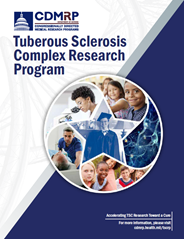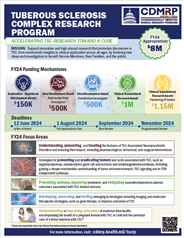Tuberous Sclerosis Complex
Vision – Improve prevention strategies and treatments to lessen the impact of TSC while striving for a cure

» Click on Image to View Program Booklet

» Click on Image to View Strategic Plan

» Click on Image to View Program Overview
Tuberous sclerosis is a genetic disorder that can affect any or all systems of the body. The disorder is characterized by seizures, developmental delays, kidney disease, behavioral problems, and the growth of benign tumors (tubers) on vital organs such as the brain, kidneys, and heart. These tumors typically calcify with age, becoming hard (sclerotic). Children with tuberous sclerosis may have autistic-like symptoms. Tuberous sclerosis affects as many as 25,000 to 50,000 individuals in the United States and about 1 to 2 million individuals worldwide.
Although this disorder can be inherited as an autosomal dominant trait, two-thirds of cases are the result of a spontaneous genetic change on one of two genes, TSC1 or TSC2. The TSC1 gene is located on chromosome 9 and produces the protein hamartin. The TSC2 gene is located on chromosome 16 and produces the protein tuberin. Hamartin and tuberin are believed to act as tumor growth suppressors. Therefore, their dysfunction may underlie the appearance of tumors that characterize tuberous sclerosis. There is currently no cure for this disease; however, surgical intervention and a number of treatments can help affected individuals.
Tuberous Sclerosis Resources
![]()
Congressional Appropriations
- $113 million
FY02-06, FY08-23 - $8 million
FY24

Funding
Summary
- 217 Awards in FY02-06, FY08-23
- Recent Applications Recommended for Funding

Programmatic
Panels

Peer Review Participants
Last updated Monday, March 17, 2025














